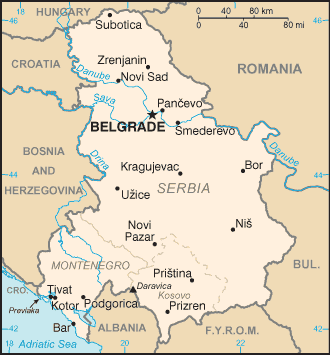World > Europe > Serbia and Montenegro
|
|
Serbia and Montenegro |
Introduction:
|
The Kingdom of Serbs, Croats, and Slovenes was formed in 1918; its name was changed to Yugoslavia in 1929. Occupation by Nazi Germany in 1941 was resisted by various paramilitary bands that fought themselves as well as the invaders. The group headed by Marshal TITO took full control upon German expulsion in 1945. Although Communist, his new government successfully steered its own path between the Warsaw Pact nations and the West for the next four and a half decades. In the early 1990s, post-TITO Yugoslavia began to unravel along ethnic lines: Slovenia, Croatia, and The Former Yugoslav Republic of Macedonia all declared their independence in 1991; Bosnia and Herzegovina in 1992. The remaining republics of Serbia and Montenegro declared a new 'Federal Republic of Yugoslavia' (FRY) in 1992 and, under President Slobodan MILOSEVIC, Serbia led various military intervention efforts to unite Serbs in neighboring republics into a 'Greater Serbia.' All of these efforts were ultimately unsuccessful. In 1999, massive expulsions by FRY forces and Serb paramilitaries of ethnic Albanians living in Kosovo provoked an international response, including the NATO bombing of Serbia and the stationing of NATO, Russian, and other peacekeepers in Kosovo. Federal elections in the fall of 2000, brought about the ouster of MILOSEVIC and installed Vojislav KOSTUNICA as president. The arrest of MILOSEVIC in 2001 allowed for his subsequent transfer to the International Criminal Tribunal for the Former Yugoslavia in The Hague to be tried for crimes against humanity. In 2001, the country's suspension was lifted, and it was once more accepted into UN organizations under the name of Yugoslavia. Kosovo has been governed by the UN Interim Administration Mission in Kosovo (UNMIK) since June 1999, under the authority of UN Security Council Resolution 1244. In 2002, the Serbian and Montenegrin components of Yugoslavia began negotiations to forge a looser relationship. These talks became a reality in February 2003 when lawmakers restructured the country into a loose federation of two republics called Serbia and Montenegro. An agreement was also reached to hold a referendum in each republic in three years on full independence. |
|
Map of Serbia and Montenegro
|
|
